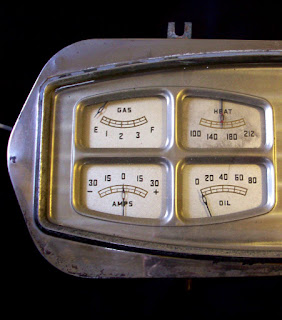It was the best of times, and it was...the best of times.
It definitely was for the Chrysler family of cars, especially when it came to the cockpit. Their three year design run was economically elegant, not as grandiose as the Pierce-Arrow or Dusenberg panels individually, but as a group, they stood second to none in understated sophistication and design.
The 1932 sets were a big step up from the humdrum, pedestrian layout of previous years. As a matter of fact, they were never really very fancy before 1932, just straight-forward utilitarian designs. But once the early-Thirties rolled around, things changed in a hurry...
 | ||
| 1932 Plymouth gauge and panel |
 |
| 1932 Chrysler dash set |
The engine-turned inlays were gorgeous, and contrasted beautifully with the starkness of the white or black gauge faces. The units were also self-contained; you could pull the instruments as one, not just individually.
In 1933, the trio decided to add a little more flash for your cash. The 1933 Dodge made a big step towards art deco decadence with their gold-tinted inlay.
 |
| 1933 Dodge dash set |
The exquisite ribbing gave the inlay an almost three-dimensional texture, in stunning gold that reflected a brilliant warm glow as you drove on a Summer afternoon.
The 1933 Plymouth distinguished itself with a softer look, an oval panel that combined the familiar Plymouth needle and number designs with the new insert styling to match the high-concept of it's automotive brethren...
 | |||
| 1933 Plymouth set |
The flagship of the three, Chrysler, wasn't about to be shown up by it's siblings, and the 1933 Lebaron set is the apex of the company.
 | |
| 1933 Chrysler LeBaron dashboard instruments |
They were also popular with the hot rodders as well. Here's a 32 Chrysler set in a 1929 Ford roadster dash...
And here's one from the September, 1955 issue of Rodding and Restyling, featuring a 1932 Chevrolet Sedan sporting the gauges
And here's one from the September, 1955 issue of Rodding and Restyling, featuring a 1932 Chevrolet Sedan sporting the gauges
1934 was the last of the art deco stylings. Dodge simply manipulated the configuration of it's gauges, Plymouth fussed with the colors, and Chrysler began the move for Mopar to separate speedometer and auxiliary gauges...
 | ||
| 1934 Dodge dash set |
 |
| 1934 Plymouth gauges set |
The Chrysler set heralded the splitting up of the "big" gauges and the "small" ones (the 1936 Plymouth combination gauge cluster was the exception).
 | |
| 1934 Chrysler auxiliary gauges |
An interesting aside is that the Desoto set mirrored the Chrysler set, with slight differences in gauge shape and color.
 |
| 1934 Desoto gauges |
The triplets of Detroit reached for a combination of high-style and functionality, and knocked it out of the park in these three years. Though the shift in design between 1933 and 1934 for Plymouth and Dodge was subtle (just enough to make the gauges incompatible with each others drill holes, so a 1933 Dodge gas gauge won't fit a 1934, grrr!) they stayed the course in presentation, assuring that the triptych of panels would forever be appreciated as a triumphant series.











Brilliant post! Unique on the internet for all I've seen, I've never found another! Bravo!
ReplyDeleteMy sister sent me a set: http://justacarguy.blogspot.com/2011/12/my-very-cool-sister-scored-these-sweet.html and your post reminded me
My favorites, the Mopars!
ReplyDeleteThat bottom set you have, the trio, those are from a boat, mid-sixties or so. I'm assuming they are brass cases?
You have a great site as well, that's why I linked to it!
Keep checking back, I will be posting A LOT more gauge info over the next few weeks.